на
главную
| |
|
Work
in Stone |
608 |
| Work
in Iron... |
611
|
| Work
in Copper, Brass, and Silver. |
624 |
| Woman's
Tailor-Work |
627
|
| Dyes |
628 |
| Dressing
of Skins and Cutting of Thongs |
629
|
| Basket-Work |
629
|
| Ancient
Pottery |
637
|
X. — MANUFACTURES.
Work
in Stone. — To judge from the stone implements preserved, it
would
seem that the Koryak, prior to their acquaintance with metals, had
not
fully acquired the art of making polished stone implements. At the
present
time, — which is still a period of transition from the use of stone
to
that of metal, — the stone tools still in use among them are mainly
made
by chipping.
With
the exception of the stone tables and hammers, which are used
without
any artificial finish, just as they are found in the beds and on the
banks
of rivers,
all the
stone implements
1 mentioned before
(see Figs.

|
35-137) are
fashioned by means of
chipping.
Stone hatchets, spear-heads, harpoon-points,
and scrapers for dre -
sing
skin, which are still in use, are
roughly
chipped out with small bone
hammers
(Fig. 134). The stone to be
chipped
is held in the left hand, the
hammer
in the right, and with its broad
end
the blows are delivered from above
downwards
on the edges of the stone.
The
thumb of the left hand is protected
against
accidental blows of the bone
hammer
by a bone thimble, and the fore-
finger
by a ring 2 (Fig. 134,
b, c).
In
the numerous irregular scratches on the
broad end of the hammer may be discerned
the traces
from blows on the uneven
stone edges.
Bone rings are at present also used for protecting the
fingers in carving wood with iron
knives.
|
| Fig. 134. a, Bone Flaker; b,c Finger- Protectors. |
|
Formerly
stone arrow-heads were also made with the bone flaker here described.
Fig. 135 shows three flint arrow-points. Such points have now
gone
out of use. Those in my collection were either obtained from people
who
preserved them as amulets or as keepsakes, or they were found by me
in
excavating ancient underground dwellings.
 1
See p. 569.
1
See p. 569.
2
It
is interesting to compare with the small bone hammer of the Koryak a similar
flaker for making arrow-
points, of the Eskimo of Baffin Land, and their method of protecting the
left hand against blows when chipping
(see Boas, Baffin-Land Eskimo, Fig. 83, p. 63).
[608]
609
JOCHELSON,
THE KORYAK.
Fig.
136
represents a spear-head (a),1 a harpoon-point (b), and an
unfin-ished
harpoon-point (c) of flint. The arrows and harpoon-heads are mostly
made
of flint, but partly of obsidian, which was formerly imported from Kam-chatka.
Spear-heads are made of flint as well as of quartz. Hatchets (see
Fig.
103) and stone skin-scrapers
are made mostly of quartz pebbles.
The
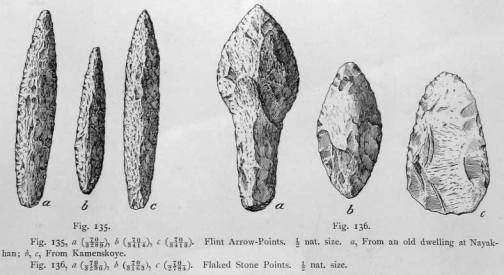
hatchets are chipped very little. The Koryak use
for this purpose flat stones
with
somewhat sharp edges, found in the
river-valleys.
Fig.
137
represents ancient slate knives for skin-cutting and other house-hold
work. The knives shown in a and 6 were found by me in excavating
the
ancient dwellings mentioned above; while c was found in the possession
of
a Koryak woman in the village of Kamenskoye, who treasured it as a
keepsake.
In the village of Kuel I found a fragment of such a knife used
as
a scraper. These relics exhibit traces of grinding and polishing. According
to
the Koryak, the edges of the knives were whetted with a flint or bone tool. The more or less even surfaces of the sides of the knives may be
explained
as due to the nature of the material, which readily splits into
thin
plates.
Sandstone
ear-ornaments (Fig. 138, a) and pendants of braids (b) have
also been finished by grinding. Stone ornaments of this kind are still worn
by
women in the villages of the Maritime Koryak. Nowadays they are
finished
with iron knives, and the perforations are bored with iron drills.
Stone
ear-rings are suspended from the ears by sinew-thread, or brass rings
are
passed through them, which are then
put into the ears.
1 A stone spear with shaft is shown
in Fig. 93, p. 552.
610
JOCHELSON, THE KORYAK.
Now here
among the Koryak did I find polished axes for wood-chopping.
The
chipped hatchets mentioned above could not have served this purpose.
I found a polished stone axe among the Yukaghir on the Kolyma tundra.
Steller1
says that the Kamchadal used to polish stone implements by grinding
them
on stones. Dittmar 2 speaks of
Kamchadal stone axes with polished
blades.
It is
hard to believe that the
Koryak never had any
polished stone
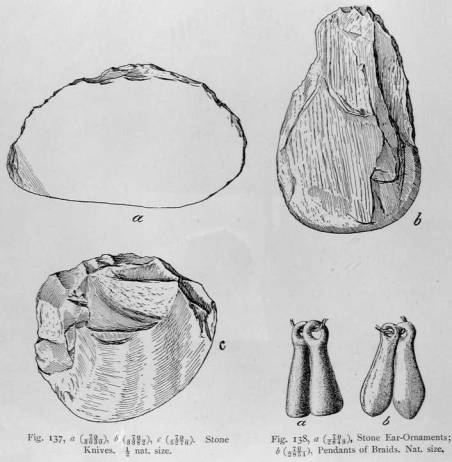
axes.
However, for wood-working,
they made more use of bone wedges and
of
the bone adze.
Among
the stone objects for household use should also be mentioned
the
stone lamps spoken of before3 and the head-piece of the fire-drill.4
Stone
lamps
are made, for the most part, of sandstone bowlders, in the upper side
of
which a cavity for
the oil is made by means of an adze or chisel.
For
1 Steller,
p. 319.
2
Dittmar, p. 214.
3 See Fig. 99, p. 566.
4 See
Part I, Fig. 2, e, p. 33.
612
JOCHELSON, THE
KORYAK.
and
the Yakut, had been working it for
a long time. Thus
we may readily
conceive
that long
before the
Koryak and other northern
natives met with the
Russians, iron
tools had
come into the hands of those
tribes through a long
series of exchanges. Thus,
for instance, on the
Kolyma tundra I heard
members
of a northern
Yukaghir clan
tell, that,
previous to the arrival of
the
Russians, they
had had
an iron
axe, the
property of the whole
clan,
which
was in
the keeping
of "the
Old Man,"
and was
carried over
the whole
tundra whenever
there happened
to be
need anywhere
of knocking
down
or cutting
in two
a thick stout
tree, which
it was
very hard to do
with stone axes.
An acquaintance of this
kind, or
even of
a somewhat
higher degree, may
have existed
also among the
Koryak. They
may have obtained iron objects, on
the one hand from a Japanese
source,1 through the Kurilians and Kamchadal;2
on the
other hand,
from a anchurian-Chinese
source, through the
Tungus. According
to historical data,
based on reports
of the Cossacks who
had reached the mouth of the
Okhota River in
1652,
the
Tungus living
there were armed with iron
and bone weapons, and clad
in
iron armor.3
There is
still a
third source from
which, during the pre-
Russian period, iron
objects may
have been derived.
I refer
to the Yakut
who represent the
Mongol-Turkish people, who
not only knew the metal and the
art of
forging it,
but also
the art of smelting iron from iron ores.4
Iron
armor,5 which supplanted the older leather or bone armor, or was
still
in use alongside of them, has, in my opinion, been known to the Koryak
prior
to their meeting with the Russians.
Let us now turn to the question of the beginning
of blacksmithing among
the
Koryak. From which tribe did the Koryak learn to forge iron ? To
answer
this question, too, is not easy. But since only in barter can there
be
intermediaries between producer
and consumer, while in
learning a trade
1
The Japanese
armor found
by Bogoras
among the
Chukchee in the northern tundra must evidently have
reached there through pre-Russian commercial exchange (see Bogoras, The
Chukchee, Vol. VII of this series, pp. 54,
164, and Fig. 85).
2
The
Cossacks who were sent from Anadyr in 1696 to conquer Kamchatka found Japanese
documents in the
Koryak dwellings of North Kamchatka.
A little later they discovered, near Tighil, a Japanese vessel that had
been
wrecked (see
Slovtzoff, Historical Survey of Siberia, p 136). This points to the
possibility of occasional but direct
intercourse in the past between the Koryak and Japanese.
3
See
Supplement to the Judicial Acts, III, pp. 333, 334.
4
For
data concerning the role of the Turkish tribes (to which the Yakut belong) in
spreading the knowledge
of iron-work in Siberia, see
R. Andree, Die
Metalle bei den Naturvölkern
mit Berücksichtigungen prähistonscher
Verhältnisse (Leipzig, 1884),
pp. 126,
[27. Popoff
(Zeitschrift fur
Ethnologie, 1878,
p. 461), in referring
to the
statement (mentioned by
me in the text)
concerning the iron weapons and armor of the Okhotsk Tungus at their
first meeting with
the Russians, expresses
the opinion that the Okhotsk
Tungus had become acquainted with iron
objects through the Yakut;
but considering the fact that the Yakut are comparatively recent arrivals in the
extreme
northeast of Siberia, and
that the
northern Tungus are supposed
to have come north prior to the
Yakut, from the
district of the
Amur River, it may be fully admitted
that their acquaintance with iron, in one way or another, is
more ancient,
and derived
ultimately from
a Manchurian-Chinese
source. Even
in the
most ancient
European
statements concerning the
ancient Manchurians,
who are kindred to the Tungus, mention is
made of their helmets
and cuirasses made of
scale-like iron
plates fastened to
one another with nails, or arranged on a skin foundation
(on this question see
Schrenck. II, p. 259, and his
references to Neuhof and Witsen).
5 See Fig. 98, p. 562; and Plate XXIX, Fig.
1.
614
JOCHELSON, THE KORYAK.
are
no beds
of ore, depend,
in the development of blacksmithing,
upon the tribes
that know
how to
smelt iron
from ore.1
Excepting the Yakut, who came
to the north in
comparatively recent times, the
civilized nations nearest to
the Koryak
that have
developed the
art of metallurgy — the Japanese and
Chinese — were separated from them
by tribes which, even
if they did adopt
from the
former the
art of
blacksmithing, did not
learn the art of mining.
Thus, leaving out the
Kamchadal, — from a technical point of view, evidently
a tribe less gifted than the
Koryak, —
the Koryak were separated
from
the Japanese
by the
Ainu and Gilyak,
who, as Schrenck
has proved,2 had
acquired the blacksmith's art from
the Japanese. From the
Chinese and from
the Yakut the Koryak were separated
by Tungus tribes.
According
to historical data, the first Russian conquerors of Siberia not
infrequently
had blacksmiths in their parties; but when compelled to work
ores,
they often had recourse to natives expert in this line of work, such as
the
Tartar and Yakut.3 In
the 'seventeenth century the higher authorities of
Siberia more than once addressed to the Moscow Government requests to
send "experts on ores" to
Siberia.
During the early times of the conquest of Siberia,
the Russian Govern-ment
forbade the selling of arms, powder, and lead to those natives who were
as yet unpacified. Krasheninnikoff says of the Kamchadal4 that
it was forbidden
to sell them iron tools and copper dishes, lest they might make
side-arms
for use against the Russians. Such conditions could not advance
the
development of the art of metal-working among those natives of Siberia
who
previous to that period had
not been familiar with it.
Of course, the blacksmith's art could develop
among the Koryak only
after
the Russians began to sell tools freely and to import iron as material for
manufacturing tools. At present the Russian Government, among other things,
keeps bar and block iron and tools in the depot established in the
village
of Kushka (the residence of the chief of the district), at the mouth
of the Gishiga River, to be sold to the natives of the Gishiga district at a price
equal to the cost price in Vladivostok plus transport expenses by steamer
to Gishiga.
It
is difficult to say exactly when blacksmithing developed as a regular
home
industry among the Koryak. We find the first printed data concerning
the
Koryak as blacksmiths in Dittmar's5 descriptions. These refer to the
middle
of the nineteenth century.
1
On the location of
iron-beds in the Kamchadal and Koryak territories, see Krasheninnikoff, I, p.
304; Pal-
las, Neue nordische Beiträge, 1793, V, p. 271; Dittmar, pp. 281, 363.
2
See
Schrenck, II, p. 255.
3
See.
for example, Slovtzoff, Historical Survey of Siberia, pp. 43, 88.
4
See
Krasheninnikoff, II, p. 48.
5
See Dittmar, Die Koräken, p. 11.
616
JOCHELSON, THE KORYAK.
the eighteenth
century were also double.1
The Gilyak and Ainu blacksmiths, too, use double bellows2
as described above,
a fact in which Schrenck finds
proof that both tribes
had borrowed the
blacksmith's art from one source, - the Japanese. As for the Tungus, to judge by statements
made by Georgi,3
their blacksmiths used simple bellows. Schrenck and Maak give the same information
concerning the Gold.4 Schrenck,
by the way, draws from this
circumstance
the conclusion that the Gold and the Gilyak had acquired the
blacksmith's
art from different sources, — the former from the Manchu-
Chinese,
the latter from Japan.
We see
that between
the Siberian
peoples using
double bellows, -i.
e.,
between the Mongol-Turks and Ainu-Gilyak, — there live Tungus
tribes
that employ or formerly employed simple bellows. It seems uncertain
whether
the invention of the Asiatic double bellows belongs to any single
people,
the more so, as double bellows are met with not only in India and Malaysia, but even among the primitive blacksmiths of
Africa. The group
exhibited
in the Paris Ethnographic Museum in the Trocadéro, and repres-
enting
a negro blacksmith with his assistant sitting between two leather
bellows,
vividly recalled to me the Yakut blacksmith.6 Still it must be said
that
the small double bellows of the Siberian blacksmith, consisting only oftwo
bags, must have been invented by a nomadic tribe. Two small skin
bags,
with a small anvil and a pair of hammers and tongs, are easy to adjust
anywhere,
and not difficult to carry from place to place. The Yakut black-
smith
has remained until our time to a considerable degree an itinerant artisan.
Usually the customer does not come to him, but he goes with his smithy
to the wealthy Yakut to fill his orders. The principle of the double
bellows,
designed to force an uninterrupted current of air into the furnace,
is
doubtless superior to that of the single bellows. On this principle are
built
the modern factory bellows, which are operated by automatic communi-
cators.
It must be supposed that among the more primitive blacksmiths,
too,
the double bellows, if not borrowed from another tribe along with black-
smithing,
are not of the
oldest type.
The
inconvenience of the double bellows above described consists in the
necessity
of having assistance in all work, as it is inconvenient for the smith now
to occupy a position between the
leather bags and then to jump out
to
1 See P. S. Pallas, Sammlungen
histovischer Nachrichten über die Mongolischen Völkerschaften, I, Plate V.
2 See
Schrenck, II, p. 255.
3 Georgi,
Part III, p. 45.
4
See
Schrenck, II, p. 254; and Maak, Journey to the Amur, St. Petersburg, 1859, pp.
175 and 207. I did not
happen to see modern bellows of the Tungus nearest to the Koryak; but the Tungus
of the Yakut Province, i. e.,
neighbors of the Yakut,
at present use,
as I stated above, the double bellows, evidently adopted from the Yakut.
5 The ancient Egyptians already
employed double bellows. Judging by ancient drawings, they consisted of
two vessels covered with skin. A slave stepped in turn with his feet, now
on one and then on the other leather
Iid of the vessel, and at the same time opened the
aperture in the other vessel. Andree (Die Metalle bei den Natur-
volkern, p. 4 ) supposes that from the Egyptians the double bellows
spread all over Africa.
618
JOCHELSON, THE KORYAK.
Koryak blacksmiths in summer. They make fires of
driftwood, and pour
water
over the coals after the wood has burned over. Then they carry the coals over to the smithy in skin bags. The Koryak blacksmith has a special
suit
for his work. In summer he works bare to the waist, dressed only in
old
skin trousers, and in winter he puts on a worn fur coat. Of course, in severe cold no work at all
is done in the smithy above described.
The
blacksmiths of Kuel and Paren work
both on merchants' orders and
for
the barter carried on by the
artisans themselves. The
Russian merchants
supply
the artisans
with iron,
and pay for the work with
tea, tobacco, and
other wares. Besides,
the blacksmiths
themselves acquire iron, hammer out
knives
and spears,
and travel
with these to the local fairs or the camps of
nomad
reindeer-breeders, and exchange the iron goods for reindeer-skins, meat,
and
furs. The
last-named are
afterward exchanged
to merchants.
Skilful blacksmiths, like those above mentioned, are paid special respect.
As among
all
primitive peoples, the blacksmith's art is not viewed by the Koryak as a
trade which every one can learn, but as a divine gift.1
In Kuel and Paren,
however, a considerable part of the
Koryak can hammer iron; and in addition
to the recognized talent,
there are second-rate blacksmiths, who work periodi-
cally, before fairs,
in order to acquire clothing and food in
exchange for the products of their art.
In general,
the villages of Paren
and Kuel may be considered as the
centres of
Koryak blacksmithing; while
Kamenskoye is a
commercial settlement in
which are concentrated the
Koryak intermediaries of exchange between the Russians and the
"Reindeer men" (Koryak and Chukchee).
In
accordance with
this, the
Parenians and
Kuelians, as
representatives of
labor, are
poorer than
the inhabitants of Kamenskoye,
the representatives
of commerce.
The
articles hammered out are finished by the blacksmiths with files.
The
art of polishing iron is unknown to them. The work of Koryak black- smiths
is limited to side-arms, tools,
and several other household objects.
Fig.
139
represents an axe (a) and an adze (b) made in Paren. The
axe
(ai'lan) is in the shape of a common Russian axe, and is used for chopping
trees
and wood. The adze (b) is mounted on a handle, axe-fashion, but its
blade is set crosswise and is curved. This tool is called "axe with ears"
(welõ-ailän).
It is used in hollowing out troughs and dug-out canoes, like a
crooked
adze (see Fig. 140, b).
Fig.
140, a, b, represents two adzes made in Paren. That marked
a is
a
straight adze (ga'tti). In shape it is an imitation of the ancient Koryak
adze
made of ivory or horn. Its handle is also curved, like that of a bone
adze.
The handle of the specimen here figured is made of bone of whale,
but
wooden handles also occur.
The blade is mounted on the handle without
1 Among the Yakut the blacksmiths
stand on a level with the shamans.' The Yukaghir blacksmiths have
special protecting spirits.
The position of the blacksmiths among the Tungus is similar.
6l9
JOCHELSON,
THE KORYAK.
a
lashing, and in
this regard
the iron adze differs from
the ancient one made
of bone. This
adze serves
for the rough
hewing of the outer side of wood
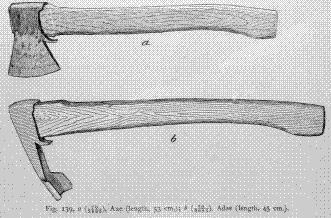
Fig. 139. a Axe (length, 53 cm.); b Adze
(length, 45 cm.).
With
it are hewn the runners and stanchions of sledges, snow-shoes, the frames
of
skin boats, etc.,
which are finished afterwards with knives.
Fig.
140, b,
shows a
curved adze
(welõ'ga'tti, "adze with
ears"), with
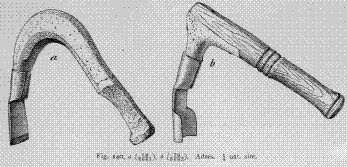
Fig.
140, Adzes.
which wooden buckets, troughs, dishes, and other wooden vessels,1
are hollowed
out. The handle of this adze consists of two
parts, — one of wood, and one
of bone, — which are
spliced together.
1 See
pp. 570, 571.
620
JOCHELSON,
THE KORYAK.
Fig.
141 shows a man's ordinary belt-knife, with a wooden sheath having
tin
rims and ears for suspending it on the belt. This knife, like all straight
knives,
has a thick back. It is called "belt-knife" (iti't-wal
or yece'twal") and
|
is
used in eating, and for work-
ing
small wooden
objects and carvings
in bone.
With this same
knife, sharpened to a keen edge,
hair is cut or shaved,1 the
hair on reindeer-skins designed
for
clothing is
cut and
rein-
deer
are stabbed
when killed for food and
not intended
as
offerings. With this knife, too,
fish is gutted
for sun-drying.
Women usually carry
it stuck
into the boot-leg.
In very rare
cases do
women carry
such
knives at the belt.
A
knife of the same form, but
somewhat longer
(including the haft, about
45 cm. in length),
is called
"hip-knife" (yõ-wal),
because it
is not carried on the belt, but is tied to the
|
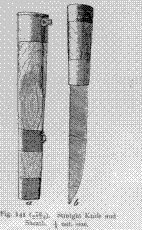 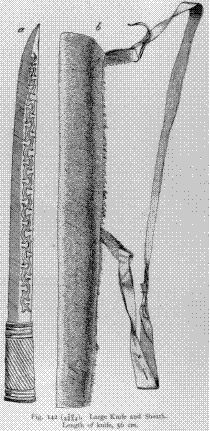 |
|
Fig. 141 Straight Knife and Sheath.
Fig.142 Large Knife and Sheath. Length of knife, 36 cm. |
1 See
p. 604.
621
JOCHELSON,
THE KORYAK.
right hip, under the coat, so as to be drawn
easily with the right hand.
With
this knife animals are skinned and grass is cut, and with its back the
foot-bones of animals are broken
to extract the leg-marrow.
Fig.
142 represents a large knife with case, called "large knife" (ma'iñi-wal),
"breast-collar or strap knife" (wa'gü-wal), or "knife carried on
one's self" (a'mta-wal).
It is carried like a sabre, across the shoulder, in a leather sheath(b)
attached
to a breast-collar. This knife was used even recently as a battle- weapon,
like a short sabre, having supplanted the bone battle-knives made of
the ribs of elks and wild reindeer. The sheath is of thong-seal skin sewed
very
roughly with sinew-thread.
The short haft of the "large knife" is made
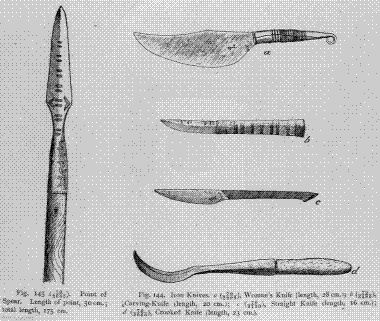
Fig. 143. Point of Spear. Length of point, 30 cm.; total length, 175 cm.
Fig. 144. Iron Knives. a Woman's Knife (length, 28 cm.); b Carving-Knife (length,
20 cm.); c Straight Knife (length, 16 cm.); d Crooked Knife (length,
23 cm.).
of bone of whale. The style of ornamentation on
this kind of iron-work
will be discussed later on.1 The major of "large knives"
are made with- out
ornament. They are made chiefly for the Reindeer Koryak. At present
wood
is split, and frozen meat and bones are chopped, with this kind of knife. Fig.
143 represents a spear
made by a Kuel smith. It
is double-edged,
1 See
Chapter XI.
622
JOCHELSON,
THE KORYAK.
long, narrow, ornamented, and well finished. The
spears for every-day use
are
not ornamented. They are of simple and rough workmanship. Some spears
are made with a ridge in the middle, which is also often met with
on
spears from the Amur region (see, Fig.
195).
Knives
for special kinds of work are represented in Fig. 144. The
woman's
knife, a (ñau-wal) is of a sickle-shape, its form being an
imitation of
the ancient flat knife made of slate.1
The
woman's knife has no sheath. It is kept in the work-bag, together
with
shavings of skin. With this knife, women cut skins and furs for clothing.2
The cutting is done on a cutting-board. Koryak women rarely use scissors.
Imported
broadcloth for the upper coat, and calico for shirts, are also cut
with
the knife. Koryak blacksmiths do not manufacture scissors. The large
shears
shown by Bogoras 3 are
the work of Yakut or Amur River blacksmiths.
Yakut
women cut skin for clothing with such scissors. Nevertheless Koryak
women
exhibited great joy when we presented them with ordinary narrow
iron
scissors in return for services rendered, or for submitting to being measured,
and
immediately pressed them into service.
Fig.
144, b, represents a knife with a long handle, specially used for
carving
in bone or wood. However, this knife is also called a belt-knife, and
is worn at the belt in a sheath. Its wooden handle is covered with
sheet-brass
which is adorned with scratches made with the point of a knife,
and
evidently representing a technical ornament. Fig. 144, c, represents a
straight
knife (tami'ñu-wal, "working-knife"), and d a curved knife (keñi-wal,
"curved
knife"), used in carving bone and wood, and in hollowing out spoons,
ladles,
dippers, plates, and dishes.
Fig. 145 represents an iron chisel and an iron
bow-drill for work in
wood.
The chisel (a) has a curved edge for making holes. The handle of
the
drill (b) and the bow are made of bone of whale. A similar bow-drill, only
with a smaller point made of steel, is used also in riveting old kettles, and generally
for boring in iron.
I
did not happen to see a pump-drill in use. It is curious that the
bow-drill
is called in the Koryak language mi'lgitine ("fire-procuring"). This
points to the fact that the use of the bow-drill for procuring fire had preceded
1
Murdoch (The
Point Barrow Eskimo, Fig. 106, p. 153) mentions an ancient large
single-edged slate knife
of this shape, belonging to the Eskimo, and supposes that it was used
specially for cutting food. I
am inclined to
think
that it
was a woman's
knife for cutting
skin. Its
shape is
quite similar to the
woman's iron knife of the
Koryak,
whose blacksmiths doubtless originally imitated ancient stone models.
In Mason's article on the woman's
knife of the Eskimo (Report of the U.
S. National Museum, 1890, p. 411) are collected types of woman's knives of
the Eskimo and certain
Indian tribes
from various localities.
These illustrations show that nearly all — both the
stone knives, and those of iron made in imitation of the stone ones
— have a crescent-shaped blade, just as in the
case of the woman's
iron knife of the
Koryak. Nearly all knives of which illustrations are given by
Mason have
handles like those of chopping-knives.
Only in three of them <see Plates LIX, LXIV, and lxviii,
Figs. I, 4, 21 do we
see a handle on the side, just as on
our woman's knife.
2
Ornamented
woman's knives are represented in Fig. 193.
3
See Bogoras, The Chukchee, Vol. VII
of this series, Fig. 151, , p. 222.
623
JOCHELSON,
THE KORYAK.
its use for drilling holes; but it is certain
that the Koryak, prior to the
introduction
of iron, were already using either a stone or a bone bow-drill to
bore holes
with. It
may be
supposed that
the holes
in stone
ear-rings
|
must have been
made
by means of
the
drill.
Fig.
146 represents
a saw
made
by
the Reindeer
Koryak
for cutting
reindeer-antlers.
It
is
made of
sheet-
iron
by means of a
file, after the pattern
of imported steel
saws.
The teeth of
the saw are
very
uneven.
Nearly
the whole
of
the Koryak black- smith's
work is con- fined
to the iron tools
above de-
scribed.
I should
mention,
in addition,
the
manufacture of,
kettles from impor-
ted sheet-iron by
Koryak
artisans.
They
beat these
kettles
out with
hammers,
and the
bottoms are fastened
on
with mortise-
locks,
in imitation
of
the imported kettles, so that they arew ell suited for cooking-purposes.
They do not make tin teapots,
as they cannot solder on the spouts. The blacksmiths also make
pick-axes
for picking ice-holes, marline-spikes, awls for sewing dog's harness,
scrapers
for dressing
skins,1 paring-chisels, bracelets, and
needle-holders.2
|
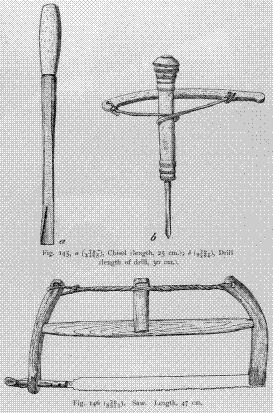 |
| Fig. 145. a
Chisel (length, 25 cm.); b Drill (length of drill, 30 cm.).
Fig. 146 Saw. Length, 47 cm. |
1
See Fig.
189, a.
2
See
also iron
fish-hook (Fig. 79,
p. 534),
harpoon and
arrow heads
(pp. 546, 559),
bird-dart (Fig.595,
p. 558), armor (p. 562), picks (p. 578), and ice-creepers (Fig. 30, p.
605).
79—JESUP NORTH PACIFIC
EXPED., VOL.
VI, PART
2.
624
JOCHELSON,
THE KORYAK.
Two
iron bracelets are represented in Fig. 147, a and 6. Small iron
bars,
finished and ornamented by means of files, are hammered cold into bracelets.
There are also twisted iron bracelets, which are made of iron rods
heated
red-hot and twisted with tongs. In Fig. 147, c, is represented an
iron
needle-case with iron pendants. For dog-harnesses the blacksmiths forge
toggles,
swivels, rings, and small chains as substitutes for those formerly made
of
bone. Files for
smoothing iron are bought by the smiths from traders or
| in the Government
depot.
Sometimes they themselves make files
of iron bars by means
of imported files. The
Koryak blacksmiths do
not make iron nails,
but they do manufac-
ture iron rivets for patching kettles and
other broken
utensils.
Fig.
147. a,b Iron Bracelets; c, Needle-Case (length, 13 cm.).
Fig.
148. aa b,c Brass Ear-Ornaments |
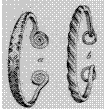 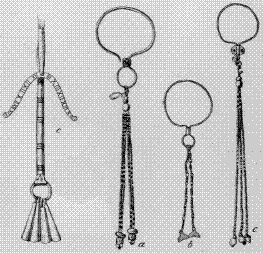 |
Work
in Copper, Brass, and Silver. — The Koryak work copper and
brass
in the cold state only. The production of objects wrought in this way is
limited. As material for the work, imported sheet-brass, copper wire, and
broken
copper dishes, teapots, and kettles, are used. Of copper or brass
wire
are manufactured large ring-shaped ear-ornaments decorated with iron or
brass pendants, or with many colored beads which are strung on sinew-thread.Fig.
148 shows three such ear-ornaments. The one marked a represents an open
ear-ring prior to passing it into the ear; and b and c, closed
ear-rings
as
they hang in the ears. Identical forms of ear-ornaments are found among
the
Tungus and the Amur Gilyak. The shape of these ear-rings, and their
manner
of manufacture, have undoubtedly been learned by the Koryak from
the
Amur tribes through the Tungus of the Okhotsk district, or they are manu-
factured
in imitation of
ear-rings brought to Gishiga from Vladivostok.
The
625
JOCHELSON,
THE KORYAK.
same may be said of the metal bracelets. I have
already described iron bracelets.
Two made
of brass are
represented in
Fig. 149,
a and
b.
The
jew's-harp shown in Fig. 149, c, is made of brass. Usually this
instrument
is made of bone. The needle-case (Fig. 149, d) is made of two
gun-cartridges,
and has
brass and
iron pendants.
The
copper of worn-out teapots is used by the Koryak for patching and
riveting
damaged copper
vessels. Spears
and large
knives are inlaid with copper and partly with brass. First the designs,
representing chevron
ornaments
and various kinds of curves, are incised with a steel
chisel.
Then copper
shavings are driven in with
a hammer, and the
weapons are
smoothed off
with
a
file.1
Silver-work, smelting, or cold-
hammering
are unknown to the Koryak
; though the blacksmiths of the
Tungus
and Yakut, the tribes nearest to them, work also in
silver.
The Tungus work is done
cold only, while the Yakut have
attained a high
degree of profi- ciency as silver- smiths. With
a hammer they
beat
out vari- |
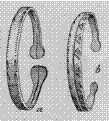 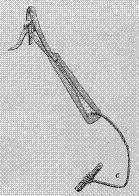  |
|
Fig.
149. a/b, Brass Bracelets; c Jew's-Harp made of Brass; d
Needle-Case made of a Cartridge |
ous ornaments and other objects from pieces of silver;
smelt silver in crucibles
of
their own manufacture, made of fire-proof clay, and then pour the smelted
metal
into moulds; make alloys of silver with other metals; engrave the most
complicated
designs on silver ornaments; and enamel silver after the style of
the Circassians. The material for this work is supplied mainly by old silver
objects and silver coins.'2
Tungus
smiths hammer silver coins into small ornaments, such as ear-rings,
rings, buttons, buckles, or little thin disks for breast-ornaments, and polish
these with a file and soft leather made of reindeer-skin. The Tungus buy larger and more ornamental silver objects, such as belts,
pendants for coats,
and ornaments for hair-dressing,
from the Yakut.
1 For
ornamentation on knives and arms,
see Figs. 142, 143, 189,
193, 195.
2 In the Yakut Province,
stories are in circulation that certain Yakut silversmiths reduce silver from
ore, but
carefully conceal the location of the mines. I could not verify the truth of these tales.
626
JOCHELSON, THE KORYAK.
The
love for silver ornaments is equally strong among the Tungus and
the
Yakut; among the latter, however, this passion has weakened of late, under
the influence of civilization. They even preferred silver to gold, though
the
Yakut well know that gold is the more expensive metal, and though
Yakut
silversmiths know how to smelt gold, too. Even the poorest Tungus
women
have some silver ornaments on their
dresses.
The
Koryak, on
the contrary,
have no
particular partiality for silver.
Even
the women
of wealthy
reindeer-breeders do not
always possess silver ornaments.
The color of copper or
brass is more suited to their taste
than the
white color
of silver. I
remember that in
Kamenskoye, when
I offered
a
Koryak woman the choice between
a wide brass ring with a
shining shield
and
a narrow
silver ring,
she chose
the former.
A contrary
result was
obtained
from the
same experiment at another time with a Tungus woman.
The Koryak call silver ñaña-polou'ntin ("easily selling iron").
This name,
therefore, expresses the superiority
of silver over iron. The
derivation of the
word for "iron" is unknown.
At any rate, it was not borrowed from the Russians.
Work
in Wood and Bone. — Wood and
bone objects, from tiny carv- ings up
to sledges,
are nowadays
wrought only
by means
of the above-described iron tools.
For fastening the parts of sledges and of the frames of skin
boats, pegs
of wood or
iron are
not used.
Everything is tied with
leather straps;
but the
Koryak are
fond of joining
their small
chests for
holding tea-dishes, or other objects,
with steel nails obtained from the Russians.
Household objects of wood have been
described before,1 and
carvings will be
discussed later. The netting-needle, and the vice used
instead of iron pincers
for finishing iron objects with a file,
are made of wood.
In
addition to the knife for cutting herring, 2 many other tools are made
of
bone, antler, or ivory. A thimble and ring of ivory, which protect the
thumb
and index-finger in chipping stone tools and working wood with the
knife,
have been described.3 Fig. 150, a,
shows a bone needle used in
weaving
baskets of grass. Fig. 150, b, represents a bone tool found by me in
excavating an old underground dwelling at the mouth of the Nayakhan River.
In
shape it looks like an imitation of an iron hammer, but with this differ-
ence,
that holes have been made in it for tying it to the handle by means
of
small leather straps. What its practical application may have been, is
unknown.
It is too small to have served for clubbing seals.4 It was found
with
potsherds; and if its shape has been copied from an iron hammer, then
the
potsherds must be of very recent origin. Fig. 150, c, represents a pair
of
ear-rings carved out of walrus-tusk with a knife. In shape these ear-rings
are
an imitation of the stone ear-rings referred to before (see p. 610), but
differ
from them in having linear ornaments.5
1
See p. 570.
2 See p. 573.
3 See p. 608.
4 See
p. 545.
5
See also bone lamp (p. 567), stool made of antler (p. 568), spoons (p.571),
fish-rake (p. 573), Picks and
pestle (pp. 577-579).
627
JOCHELSON,
THE KORYAK.
Of
bone tools, the following, besides those already mentioned, are still
in
use: an axe of bone of whale, with which bark is peeled from trees to
get
gum, and with which sods are cut for covering the walls and roofs of underground
houses;1 a marline-spike (Fig. 151),
which is indispensable on account
of the extended use of lashings; bone combs 2 for
combiner sacrificial grass;
and plant-stems for technical purposes. In the absence of iron, toggles
and swivels for the dog-harness are
made even now of bone or antler.
For
|
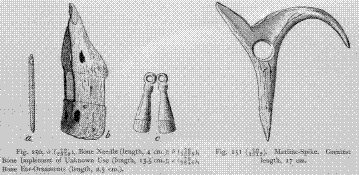
|
| Fig. 150. a, Bone Needle (length, 4 cm.);
b Bone Implement of Unknown Use (length, 13.5 cm.); c Bone
Ear-Ornaments (length, 2.5 cm.). Fig. 151. Marline- Spike.
Greatest length, 17 cm. |
making bone swivels, a ring made of the bone of a
mountain-sheep is placed
in
boiling water, in which it expands and softens. Through this is passed
the
small head of a bolt, usually cut out of a walrus-tusk. After drying, the
ring
contracts around the body of the bolt, and the head cannot come out.
Finally may be mentioned the Koryak bone-scraper described by Bogoras.3
Woman's
Tailor-Work. — All the clothing is made by women. The
sewing
for each family is done by the adult women, but girls from the age
of
twelve or thirteen on assist their grown-up relatives. Among the tailor's tools,
the woman's knife has already been described.4 Next, the needle and
cutting-board
should be mentioned. At present only imported steel needles
are
used. For sewing heavy skin clothing, only long thick needles are used.
Special
preference is given by the women to sailor's needles, with which they can pierce more easily than with round needles the thick skins
used in winter
for
the inner sleeping-tents and the large outer tents. The cutting-boards
are
made in different
sizes. For
the most part, they are plain alder,
poplar,
1 It is curious to note that the bone
axes that I have seen were mounted on a wooden handle, with the
edge of the blade parallel to the handle, like iron axes, and not like
adzes, as was formerly done. Thus, in the
epoch of the transition from stone to metal is found not only the
tendency to give metal tools the shape of tools of
stone or bone, but also the contrary
tendency to adopt for bone or stone tools the forms of imported iron tools.
2 See
Part I, Fig. 42, p. 97.
3 See
Bogoras, The Chukchee, Vol. VII of this series, Fig. 147, p. 219.
4 See p. 621.
628
JOCHELSON, THE KORYAK.
or larch boards, about half a metre long and
15-20 cm. in width, planed
off
with an adze. On the reverse side, figures representing human beings
and
animals, and other ornaments, are carved out with a knife.1 The small
pieces
of white and black fur for making up patterns on clothing and rugs
are
cut on small ornamented boards with a wide notch in the middle, on
which
are wound the embroidered fur strips for trimming coats.2
Fig.
152 represents
an ornamented double wooden
trinket-box with a
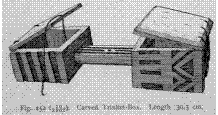 |
connecting hollow bar around
which
embroidered fur strips are
wound.
The two small boxes
serve
for holding needle-cases, thimbles,
slittingtool, patterns, and
other trifles. The wooden lids
are fastened to the outer sides
of the boxes with leather
strips
instead of hinges. They
are
closed by
a sinew-thread |
| Fig. 152. Carved Trinket-Box. Length 30.3
cm. |
|
which
passes from one lid to the
other through the hollow bridge connecting
the two boxes.
Thread is still made of reindeer-sinew. For
sewing-purposes the thin
threads
of the dorsal sinews are used, while the thick sinews taken from the
legs serve to make ropes for netting and for basket-weaving. The sinew is
pounded
with a stone hammer on a stone table, and combed like flax with a
bone comb; then threads or ropes of the desired thickness are twisted out
of
the thin fibre thus obtained.
Plate
XXXVII shows women of the Maritime Koryak sitting sewing and
cutting
by the dim light of an oil lamp. On the right side a boy is sitting
on
the log which separates the sleeping-space from the middle of the house;
a
girl with her sewing, and a woman with a child, are sitting behind the
log,
on skins, under the raised cover of the sleeping-tent. On the left are
seated
a girl, and a woman with a cutting-board. Above are hanging clothes,
foot-wear,
and a fur rug. The sewing of reindeer-skin rugs will be described
later
on.3
Dyes.
—
The Koryak use a variety of dyes for dyeing skins, animal
hair
or fur for ornaments, and thread for weaving bags and baskets. For black
or dark dyes they employ sea-mud, a decoction of swamp-moss and pounded
coal mixed with fish-glue, or a decoction of berries of Empetrum nigrum with burned grass of Elymus mollis. With the
first two is dyed the
bark of the willow-herb (Epilobium angustifolium), of which bags are woven.
Previous to being twisted into thread, this bark is soaked in sea-mud
gathered
on the coast after
high tide, or in a hot decoction of swamp-moss.
1 See
Fig. 194.
2 See
Fig. 196, a, .
3 See
Chapter XI.
Jesup
North Pacific Expedition, Vol. VI.
Plate XXXVII
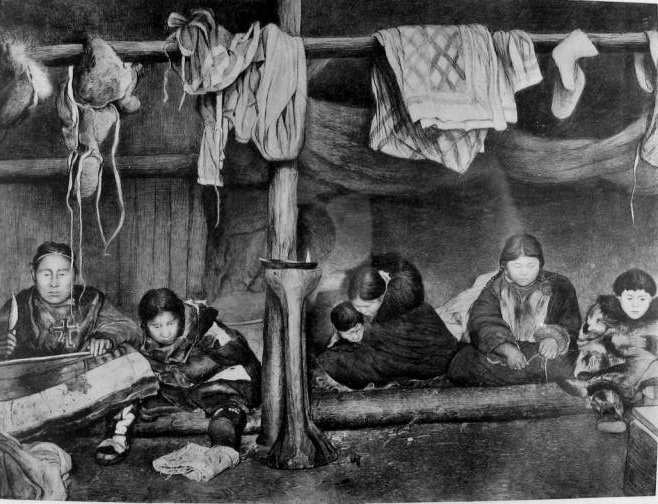
INTERIOR
OF HOUSE.
629
JOCHELSON,
THE KORYAK.
Pounded
coal mixed with fish-glue is used for coloring sledge-stanchions,
engravings
on bone carvings, sinew and nettle thread, and sometimes wood- carvings.1
A decoction of cranberry with ashes of Elymus mollis is used in dyeing
black the strips and pieces of ringed-seal skins and of the thin skin
from
dogs' necks,
which are
used for
ornamenting clothing.
Red dyes
of various hues are made of ochre, alder-bark, and of berries
of
Empetrum nigrum.
Ochre is
used also
as a paint, — either
dry (for
instance,
in painting
the cheeks
of wooden
masks2), or dissolved in water.
Alder-bark serves mainly for dyeing dressed reindeer-hides, from which clothing
is
made to be worn with the fur side in.
Dressed skins are rubbed with it,
or it is boiled in water and the
skin is soaked in the hot decoction.
In the
former
case an uneven reddish dye results; in the latter, a bright even cinnamon
color
is obtained. Special
skill is required
for this process.
Expert workers
are
found among
the Maritime
Koryak women,
who know
how to
lay a very
showy bright cinnamon hue on skin.
After being treated with hot alder- dye,
the skin hardens, and must be
rubbed afresh to render it soft.
Dressing
of Skins and Cutting of Thongs. — In the Koryak household,
dressing
of skins and cutting of thongs are important occupations, as all of the
clothing is made of skins, which must first be dressed; while thongs are
needed
not only for lines, breast-collars, lassoes, harness, etc., but also for tying
together sleds, for nets,
and for many other necessities.
The
dressing of skins is the task of women, while thongs are cut by
men.
The methods employed in both these industries are identical among
the
Koryak and Chukchee, and for the description of details the reader is
referred
to Bogoras's work on the Chukchee.3 I will only remark that in
certain
places these occupations develop into home industries. This is particu- larly
true of the making of thongs. Strong thongs are obtained only from
sea-animals.
Accordingly the Maritime Koryak manufacture them, and ex-
change
thongs of ringed-seal and walrus-hide
with the Reindeer Koryak.
Basket-Work.
—
The bags and sacks made of seal-hides and reindeer-skin
have been spoken of before (see p. 607). Here I shall confine myself to
a description of the manufacture of woven bags and baskets. Like the
manufacture
of clothing, weaving is the occupation of women, and it is developed
chiefly among the Maritime Koryak. The material for weaving is
quite varied. The roots of different species of willow, the wild rye (Elymus
mollis; Koryak, tu'wai), willow-herb grass {Epilobium
angustifolium; Koryak,
me'nmet
or me'nmetan), nettle (Urtica disica L.), thread from reindeer-sinew,
and
imported twine, are used.
Willow-roots,
previous to weaving, are soaked in warm water, by which
process
flexible white
rods are
obtained. The
stems of the Elymus mollis
1 See for instance, the wooden dog (Fig.
178, a) dyed in black.
2
See
Part I, p. 84.
3 See Bogoras, The Chukchee, Vol. VII
of this series, pp. 217, 228.
630
JOCHELSON,
THE KORYAK.
are gathered in autumn. This plant grows on
sloping sandy river-banks, and
often
reaches the height of a man. The women cut it down with knives, and
carry it in sheaves to the villages. The grass is twisted into braids
(Fig.
153,
a), and bunches of these are hung on sticks in the storehouse.
The
outer bark of the edible willow-herb1
(Epilobium angustifolium) is
|
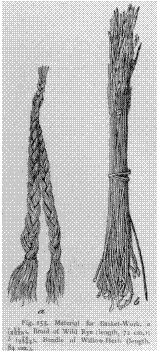
|
used for technical purposes. The pith is taken out
and used as food. Thread is twisted
from
the bark in the same way as from nettle.
The
winter supplies of willow-herb are gathered
also
in the fall, and are preserved in bunches
(Fig.
153, b).
The
Koryak must have used nettle for
weaving
before meeting with the Russians.
From certain passages
in Dittmar's2 book on Kamchatka, the conclusion might be
drawn
that the Russians had taught the
Kamchadal how to treat nettle for
text ilepurposes; but Krasheninnikoff and
Steller, who wrote
of
Kamchatka nearly a century before
Dittmar,
speak of the use of nettle for nets
and bas-
kets as a long-known industry of the
Kam-
chadal 3
The
Koryak women gather nettles also in
autumn,
after the end of the fishing-season,
tie
it into bunches, and hang it under the
storehouses
to dry. In winter they work their
yarn.
With their teeth they pull off the soft
fibres
from the hard woody nettle-sterns, pound
them
with a stick until the fibres come apart,
and
then twist these in the same way as they
do
sinew-thread.
I
have already spoken of the use of sinew-thread
in sewing. For
basket and bag weaving
|
| Fig. 153. Material for Basker-Work. a Braid
of Wild Rye (length, 72 cm.); b Bundle of Willow-Herb (length, 84 cm.). |
or
netting, strands
are made
of from
four to six fibres,
which are twisted
together.
The spinning of the thread for weaving from these plant and sinew
1 See p. 578.
2
Dittmar, Travel in Kamtschatka, pp. 160, 164, 363. It is quite possible that
what Dittmar says does not
refer to the preparation of nettle by the Kamchadal in general, but to
the endeavors of Zavoyko, Governor of
Kamchatka, to accustom them to an improved method of treatment by means
of spinning-wheel and weaver's loom.
But from the passages referred to in Dittmar it is not quite clear that
he wanted to speak only of improvements
in the Kamchadal method of manufacture. I do not know
whether the better method introduced by the Russians
has been preserved among the Kamchadal, but the Koryak employ even now
the most primitive method of prepara-
tion
of nettle.
3 See
Steller, pp. 83, 317;
Krasheninnikoff, I, p. 332.
631
JOCHELSON,
THE KORYAK.
fibres has not advanced beyond the method of a
cobbler preparing his waxen end.
The twisting is done with the palms of the hands,1 and
a long thread
is
obtained by twisting together separate parts. Fig. 154
represents
a wooden
reel
on which
is wound
the sinew-thread
for weaving.
Similar skeins are made
of the threads of plant-fibres.
|
When
a Koryak woman comes into
possession of imported
flax, hemp,
or cotton thread
or cord, she
uses it by mingling it in her work
with home-made material, so that
stripes of one and the other material
alternate. Sometimes
it happens
that a
Koryak woman purchases
linen cloth, unravels it, and
twists the ravellings into cord for
weaving. |
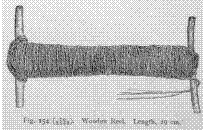
|
|
Fig. 154. Wooden Reel. Length, 29 cm. |
Among
the Koryak,
as among the Alaskan Eskimo,
we find coiled and twined
basketry; but
in
the
majority of
cases the
work of the Koryak is better,
and their methods
are more varied, than those of the
Eskimo. Fig. 155
represents
one
of the varieties of
coiled baskets. They
are
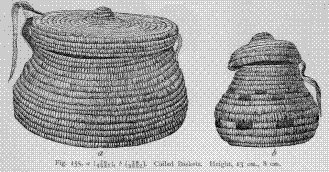
Fig.
155. a,b Coiled Baskets. Height, 13 cm., 8 cm.
children's baskets, made of Elymus mollis; but
larger-sized baskets of the
same
shape are used by women for berry-picking. Fig. 156
represents one
square
inch of
Fig. 155,
a, enlarged.
As may be seen, the work is done
1 It is interesting to note that an
improved method of twisting thread is employed by the Yakut women,
who twist with the palm of the right hand on the bare thigh. The origin
of this method is explained by the
Yakut woman's dress, the lower part of which consists of three pieces,
— short trousers, knee-piece, and boots. In
working
thread, the Yakut
woman takes
off the knee-piece
of the right
leg, and, raising her
coat, twists on her bare thigh.
8O—JESUP
NORTH PACIFIC
EXPED., VOL. VI,
PART 2.
632
JOCHELSON,
THE KORYAK.
quite roughly, and differs in no way, in material
and device, from the same
kind
of basket-work of the Alaskan Eskimo, which has been described by Mason.1
Bunches of straw are used for the body of the coil. In whipping each
coil with a straw thread,
the upper part of the lower coil is
caught i
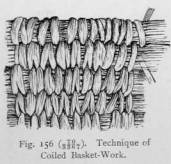 |
thus fastening the coils together. The straw
whipping-thread
is passed through the bunches of straw
that serve as the foundation by means of a
bone or iron awl. As may be seen from the
illustration,
the women do not observe any regu-
larity
in passing the binding through the lower
coil.
In whipping they pass the thread either
through
the lower coil or into the interval between
two
coils, just as the Alaskan Eskimo2 do.
The
ornamentation of this
kind of baskets is
made
with straw
dyed black
or red,
which is
|
|
Fig. 156. Technique of Coiled
Basket-Work. |
|
used
for whipping
the coils,
and alternates rhythmically with undyed straw
thread (see Fig. 155,
b).
These
baskets are
circular in
section, and the
diameters of the circles
grow smaller in size going upward.
The rim usually consists, not
of straw,
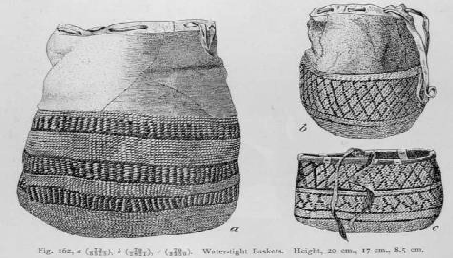
Fig.
157. Coiled Grass Basket. Height, 14 cm. b, Detail from bottom of basket.
but of a willow rod coiled with sinew thread
instead of straw thread. The
lid is separate, and is fastened to the basket with a small strap. On the opposite
side, straps for closing the basket are fastened.
1
See Mason, Aboriginal
Basket-Work, Figs. 5, 6, p. 293.
2
For
a sample of cleaner work and regularity of stitches, see the Zuñi coiled
basket-jar in Mason's Aboriginal
Basket-Work, Plate
xlix, Fig. 81) and the
fabrics from a cave in Kentucky (Holmes, Prehistoric Textile Fabrics of
the United
States derived
from Impressions
on Pottery
in the Third Annual
Report of the Bureau of Ethnology
I881-82, Fig. 67, p. 403).
633
JOCHELSON,
THE KORYAK.
Fig.
157
represents a type of coiled basketry made of Elymus mollis; but
the
coils of straw are whipped with twisted sinew thread, and not with straw thread.
In b a part of the
bottom of the basket is shown on a larger scale.
|
The straw coil forms a spiral.
The
coils are whipped and held
together by a sinew
thread,
also without any regu-
larity,
like the straw thread
in
the preceding figure. The whipping
is done with a
bone
needle like the one
shown
in Fig. 150, a.
Fig.
158 represents a bas-ket
made of willow-roots on
the
river Opuka. The mate-
rial for whipping
consists of
splints of willow-roots.
|
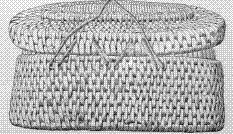
|
|
Fig. 158. Coiled Basket made of
Willow-Roots. Width, 22 cm. |
This basket,
too, belongs to the coiled type, but differs from the two preceding- figures
in the style of coiling. Rods made of willow roots or branches form
the
warp. Beginning
from below, the splint
of the root whips two rods of
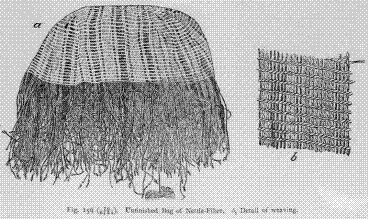
Fig.
159. Unfinished Bag of Nettle- Fibre. b, Detail of weaving.
the warp at once. In this process a space equal to the
width of the splint
is
left between each whipping. Then a third rod is added above, and is
fastened
to the second rod in the same manner, but so that the stitches pass
under
the second
rod between
the stitches
joining the
first pair
of rods.
634
JOCHELSON,
THE KORYAK.
Attention may be called to the neatness and
regularity of this work. The
seam nowhere passes
over the preceding whipping, as it does in grass basket-
weaving.
The shape
of these
baskets, which are oval in
cross-section, and
|
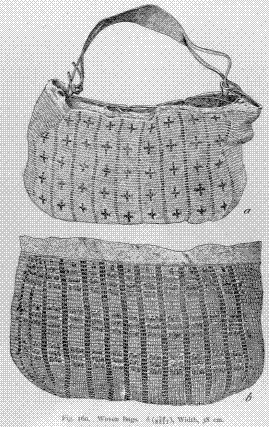
|
the form of the lid,
suggest
that they
may
be an imitation
of
some imported
model. In material
and technique, this
basket is exactly identical with that
of the Tinné, who,
as Mason supposes,
taught the Alaskan
Eskimo to weave.1
Baskets
or bags
made in twined
weaving are open
and close. The lat-
ter are waterproof.
Fig.
159 repre-sents an unfinished
woven sack made of nettle-thread, and
a piece of the sack, on a larger scale,
showing the method of weaving. An
empty sack is so
soft that it may be
rolled up. After
the warp-threads on
the bottom of the
sack are fastened
by the woof-threads,
the sack is hung up
on two poles or on a stretcher. At the end of the warp-thread, knots
are made, lest the twisting
should
be undone during the work. Certain rows of the warp-threads are
black,
and alternate
in regular
order with
rows of
undyed threads,
thus
Fig. 160. Woven Bags. b, Width, 38 cm. |
1 See
Mason, Aboriginal Basket-Work, Plate V, p. 295.
635
JOCHELSON,
THE KORYAK.
determining the ornamental style of the bag. The
weaving is done by twining
two
woof-threads over the warp. The end of the woof is gathered in a skein and
undone according to need. The weaving continues round the sack from
right
to left.
Fig.
160 represents
flat bags
like those
on the
preceding figure, but
finished.
In b
a strip of seal-skin is
stitched around the opening of the bag.
It
is sewed
with sinew-thread to the
last woof-threads,
to which
are also
fastened
the loose ends of the
warp. This bag
has never been in use, and
in the skin strip at the opening
are no holes through which to pass the thong
which
is to close the bag when full (Fig.
160, a). The workmanship of these
bags exhibits
great taste
and skill. The
ornamentation of the bag is made
as
follows: at
certain intervals
among the
nettle-threads of the warp there
run
three threads of sinew, dyed
black, which thus form narrow black longi-
tudinal
stripes between
wider stripes
of the light-gray nettle.
These alter-
nating
stripes of
various colors
make a pleasing impression.
The width of
the
light stripes varies; and this somewhat disturbs the impression which the ornamentation
would produce
on the
eye if
it were executed with greater
regularity.
The bag
is further ornamented with bunches of colored crewel,
which are caught in
the twining,
forming tassels similar to those shown in
Fig.
199, a. This ornament
forms three cross-stripes.
Of these, the lower
two
consist of three rows; the upper one, of four rows.
On the bag marked a, instead of the bunches
which form the cross-stripes,
there is an embroidery of crosses in colored wool, the regular arrange- ment
of which produces a very pleasing effect. The black cross-stripes consist of threads made of the outer bark of Epilobium angustifolium dyed
in
sea-mud.1 To this bag is attached a woman's carrying-strap or
head-band.
|
The
twined bags here described serve for carrying goods on foot-journeys.
Women carry them by means of a head-band; men,
by
means of a chest-yoke.2 In them women also carry
children (see Plate XXXVI). In the Koryak tongue
every bag or basket is called apke'lin; bas-
kets
with ornamentation, kele'-a'pkel ("ornamented
baskets");
while the coiled baskets described before
are
called tene'-apke'lin ("sewed basket"). |
 Fig.
161. Techniqne of Twined Basketry. Fig.
161. Techniqne of Twined Basketry. |
|
|
Fig.
161
shows the
method of weaving close-
twined
baskets. Elymus
mollis is pre-eminently the material used for this purpose; but the work on them is
more perfect than
the
work on coiled baskets of the same straw. The warp is formed by
threads
of twisted straw of Elymus mollis.
The weaving is done by twining
1 See p. 628.
This method of dyeing
textile material black is found
also among the Haida (see Mason,
Aboriginal
Basket-Work, p. 297).
2 See p. 606.
636
JOCHELSON,
THE KORYAK.
with two straw threads. This method of weaving
produces a texture dense,
waterproof,
and yet flexible and not coarse. Fig. 162 shows three baskets
woven by this method. The ornamentation of these sacks is obtained by
weaving in threads of Epilobium angustifolium dyed black. In a the
threads
from
this grass have been dyed in a decoction of swamp-moss. To this dye is
added a little fish-oil, which gives it a glossy hue. Bags woven in the
way
here described vary in size. They are used chiefly as women's work- bags.
In the
majority of
cases the
upper part
(a third or a half) of
the
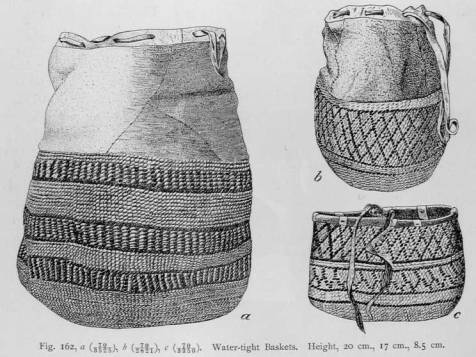
bag consists of reindeer or seal skin stitched to
the woven part, as shown in
a and b. Around Penshina Bay the Koryak women, among whom I collected
all
the above-described specimens of basket-work, do not weave (at least at present)
any grass mats; but the Koryak of northern Kamchatka, like the
Kamchadal,
make grass mats. Fig. 163 represents a grass basket for berries,
of
the Koryak of northern Kamchatka, which is of cylindrical shape, and
is
made in twined weaving. In neatness, workmanship, and ornamentation,
the
basket recalls the best specimens of Indian basketry of the North Pacific
coast.
Mr.
Bogoras has collected in northern Kamchatka a few grass bags which
show
a different technique. They are made throughout of braids of grass. The
bottom is
formed by a long
narrow strip of skin, to one end of which
637
JOCHELSON,
THE KORYAK.
the first braid is sewed. The braid then continues
spirally around this strip
of skin, the spirals being sewed together. These bags are ornamented by
inserting
at a certain place a dark or ornamented braid, which occupies one turn
of the spiral, to be followed by a plain turn, which again may be fol- lowed
by a decorated turn. Thus it happens that at one place in the basket
the
ornamented and unornamented strips are sewed together, and the irregular
|
appearance is presented because the orna-mented turn of the spiral always ends one
row above the point where it begins. This
technique
is shown in Fig. 164, b. In this case the lower part of the basket
is
made of coarse braid, while the upper
two-thirds
are made of a much more
closely
woven braid. In Fig. 164, c, the
insertion
of the decorative band is made
in
a different way, a single black spiral
being inserted, which
tapers at both ends.
The technique of this style of basketry
is shown in Fig.
164, a.
The
Maritime Koryak are about the
only
part of the tribe engaged in basket-
weaving
from plant and other fibre.
The
Reindeer Koryak women have no
time,
and their large cold tents are un-
suited
in winter for carrying on the work
of
preparing the material and weaving
the baskets. The Reindeer Koryak wo-
men
content themselves with sewing-bags
made of skins
and with
the woven baskets
obtained by exchange from the women
of the Maritime tribe.
|
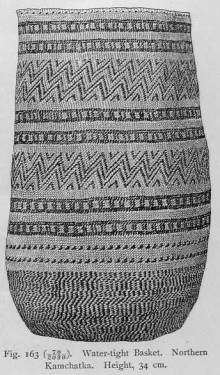
|
Ancient
Pottery. — I have referred several times to the excavations
of
ancient Koryak underground dwellings, which I made at the mouth of the
river Nayakhan and on the seacoast between the mouths of the rivers Naya-
khan
and Gishiga. Before undertaking to describe the potsherds found in
these
excavations, I will make a few general remarks on the remains of these
underground
dwellings and how the excavations were conducted.
The Koryak themselves consider these remains as the
dwellings of their
ancestors,
who had lived there previous to the advent of the Russians, and
they call them by the same name as they call their present underground
dwellings (see pp. 448, 453). These dwellings are therefore the dwellings of
the
Koryak, and not those of another tribe, and they are not very ancient.
Seen
from the
outside, these
remains form
circular or
nearly circular
638
JOCHELSON,
THE KORYAK.
shallow pits with small embankments, and resemble
the remains of under-round
dwellings on Yezo, as described by Dr. Grimm.1 Grimm calls atten- tion to the charred posts found in his excavations. In some pits I also found
that the posts which evidently supported the roof were completely charred.
The
Koryak explained
this by stating that the
Russian conquerors or other
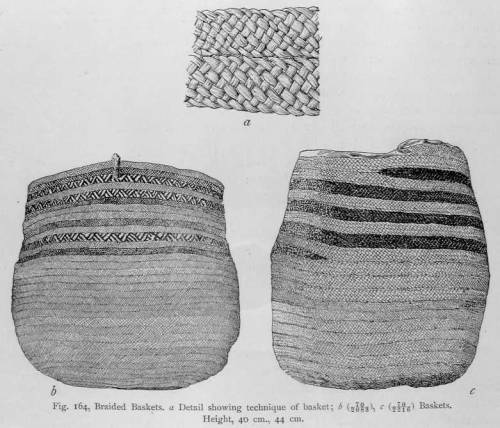
foes
had set fire to these dwellings, — a practice quite frequent in antiquity
when
those besieged in the underground house would not surrender.
Much
to my regret, I was unable to carry on systematic excavations.
The method of my travels precluded a long stay in those regions. Besides, it
was in the month of July, when the soil was still frozen to the depth of one
foot; so that digging was impossible, and the ground had to be broken with an axe. Therefore no amount of precaution could prevent the breaking
of
the articles found. Being unable to make regular and extensive excavations,
I
confined myself
to digging
up the
centres of
the holes in
the hope of
1
Grimm,
Beitrag zur Kenntniss der Koropokguru auf Yezo u. Bemerkungen über die
Shilkotan-Aino (Mittei-
lungen der deutschen Gesellschaft
für Natur- und Völkerkunde Ostasiens in Tokio,
1892, Band V, pp. 369-373).
639
JOCHELSON,
THE KORYAK.
discovering the location of the fireside. I really
did find charred logs, coals,
stones
forming the hearth, potsherds, and remains of tools. Let us now consider
the potsherds.
All
the potsherds found by me are made of coarse clay, containing fine
gravel
and pieces of quartz. They are quite thin (4 -12 mm.), so that their manufacture
has little in common with that of the thick and clumsy clay
lamps and unbaked
quadrangular kettles of the modern Chukchee and Asiatic
Eskimo described by Bogoras.1
The potsherds found in the excavations are
black with soot and fat, and were
evidently well baked, as they remained
strong and hard, although they had been
lying in the wet soil.
The
Koryak themselves well know that the potsherds now found are
remnants
of the clay vessels in which their near ancestors used to cook their
food. The Koryak call a clay pot sEku'keña, i. e., "clay kettle" (from
sa, "earth
and
clay;" and kukeña, "kettle or pot"). Iron kettles are called by them
polounto-kukeña.
In
a myth2 it is related
how Yiñea-ñeut, when a child, was deserted by
her father Big-Raven in an underground house. There she grew up alone, caught
birds, and cooked them in the clay pot she found behind the fireplace.
The
mentioning of pottery in mythology shows that the Koryak themselves
assign
to pottery an ancient origin.
A fairly accurate idea of the size and form of
the whole pots may be
gained
from the fragments. The restoration of a pot is shown in Fig. 165, a.
Its
mouth has a diameter of about 21 cm., and its height must have been approximately
24 cm., while the walls are 4—8 mm. thick. The pot is
moulded
with the hand, and the outside bears all over it the impressions of
close-woven
twined basketry, such as is shown in Fig. 161.
Evidently this impression
was made by taking a piece of twined fabric in one hand, and
pressing
it against the moist pot, the twined woof being placed so that the lines
run at right angles to the rim. In some fragments of pots the impress
of this woven fabric is very distinct. Another fragment in the collection indicates
that the pot of which it once formed a part must have had a still
larger
diameter. The piece is too small to reconstruct the exact form of the
pot,
but it would seem that the pot was not less than 30 cm. wide at the
mouth. All the pots are covered with a heavy layer of soot. A thick pot-
sherd
showing a decorated rim is shown in Fig.
165, b.
The
unquestionable existence of pottery among the Koryak in the recent
past
presents great interest, in view of the fact that the former existence of
pottery
among other so-called palae-Asiatic peoples has been disputed by many
writers.
Let us consider, first of all, the Kamchadal, a neighboring tribe kindred to
Let us consider, first of all, the Kamchadal, a
neighboring tribe kindred to
1 See Bogoras, The Chukchee, Vol.
VII of this series, Figs. 102—104, pp. 185, 186.
2
See
Part I, p. 306, No. 114.
1 See Sleller, p. 322; Krasheninnikoff, II, p. 45.
8l—JESUP
NORTH PACIFIC EXPED., VOL.
VI, PART
2.
640
JOCHELSON,
THE KORYAK.
the Koryak. True, Steller and Krasheninnikoff 3
visited them after they had
been
considerably influenced by Russian culture; but, in speaking of the ancient
Kamchadal method of cooking food, they mention only boiling in
wooden
troughs by means of red-hot stones, and there is nowhere in the writings
of these authors a reference to clay vessels. Schrenck considers the
absence
of pottery among the Kamchadal as
proved.1
I
have found accounts which stated that the Koryak also used red-hot
stones
for boiling. However, in these statements I do not see any contra-
diction
to the fact that there are traces of the existence of pottery among them.
The latter, to my mind, seems a later invention than boiling by means
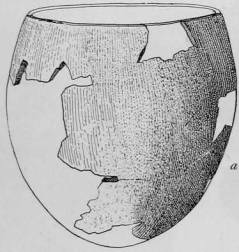
|
 |
|
Fig. 165. a (70/5330), Pottery
Vessel; b (70/7960), Rim of Pottery Vessel. |
of red-hot stones; but, even after the
invention
of pottery, cooking by means of
red-hot stones might have continued. But
as iron kettles were acquired,
the manufacture of
clay pots probably disappeared earlier than the custom of
boiling with stones in troughs, as may
have
been the
case with
the Kamchadal. Witsen2 states, based on information given by Cossacks, that theKamchadal
used to make clay vessels. In an old underground Kamchadal dwelling,
Dittmar found "small clay vessels" of most primitive workmanship. "The
clay crumbled under the hands, it had evidently been badly (if at all)
baked,"
says Dittmar. As the pots were saturated with blubber, Dittmar
thinks
it possible that they had been lamps, and not cooking-pots ; 3 but
this
opinion
may be offset by the shape and size, especially the depth, of the
pots
found.4 Besides, in another passage, Dittmar quotes the tale of an
old
Kamchadal
who brought
to him
the stone implements that he had dug out
1 Schrenck, II, p. 140.
2 See Witsen, Noord en Oost Tartarye,
1705, p. 673.
3 See
Dittmar, p. 213.
4
Dittmar
gives the following measurements of the pots: upper diameter, 12 cm.; lower, 10
cm.; maximum
width, 14 cm.; depth, 10 cm. This vessel, therefore, had an aperture smaller in
diameter than the middle part, and
its bottom was still smaller than the aperture. Clay lamps are of
different shape (see Bogoras, The Chukchee,
Vol. VII of this series, Figs. 102, 103, pp. 185, 186; Nelson, Plate III).
Nelson gives 2| inches (i.e., less than
7 cm.) as the depth of two lamps (Nelson, p. 64).
The Koryak stone lamps (see p. 566)
are 4 -6 cm. deep.
641
JOCHELSON,
THE KORYAK.
of ancient underground houses, and who said that
potsherds of coarse clay
vessels
are often found among other objects in excavating ancient underground dwellings
on the eastern
coast of Kamchatka.1
Lastly,
the Gishiga Cossacks, who often visit Kamchatka on duty, told
me
personally that they came across the same kind of sherds of clay pots as
I found in the ruins of ancient Koryak houses.
At
present neither the Gilyak and Ainu, nor the Kamchadal and Koryak,
make
clay pots. Schrenck expresses the opinion that even in antiquity this
art
was unknown to the Gilyak and Ainu.2 Concerning the statement of the
Japanese
traveller, Mamia Rinso, that the Gilyak on Saghalin manufactured clay
ware resembling that of the Chinese and Japanese, Schrenck supposes
that
this art was introduced by the Chinese and Japanese at a quite recent date,
and has been lost again. On the other hand, Schrenck finds that the
potsherds
collected by Pfeiffer, Lopatin, and Polyakoff in various parts of the
Amur
region and in Saghalin, samples of which were in his hands, were so
old as to have no ethnological connection whatever with the tribes inhabit- ing the region at the present time.3
Leo Sternberg, the latest student of the Gilyak
tribe, in his brief pre-liminary
sketch of the Gilyak, published in the "Ethnographical Review," 4
ex-
presses
an opinion concerning the ancient Gilyak pottery identical with that
of
Schrenck. In his opinion, the Gilyak were not familiar with pottery.
Further
on, I shall briefly touch upon his arguments. The Gilyak themselves call the remains of the ancient underground dwellings on
Saghalin Island, where
the potsherds were found, kugi-tulkc, which means "Ainu little pits;"
i.
e., the Gilyak attribute them to the Ainu. Following the course of his
arguments,
Sternberg further supposes that these little pits did not belong to
the ancestors of the present Ainu either, for the Saghalin Ainu themselves
attribute
them to another people by the name of Tonchi.5
Here
I reach a question interesting in the highest degree, — the
uestion,
Who were the ancient inhabitants of Japan and of the underground dwellings
in Yezo and other places, — the Ainu, or another pre-Ainu people?
This
question divides Japanese and other investigators into two camps. Of
the
Japanese scholars, Professor Koganei especially, espouses the former view;
Professor
Tsuboi, the latter. Concerning Saghalin, my friend Dr. Sternberg
apparently
seems to
side with
Tsuboi; while Dr. Laufer, a
member of our
1 See Dittmar, p. 189.
2 See Schrenck, II, p. 139. Schrenck,
by the way, expresses the opinion that pottery was unknown to any
of the so-called palae-Asiatic peoples, with the exception of the Eskimo. He
supposes that the Eskimo came to
America from Asia, and classes them among the a-Asiatics; but this
opinion, as we see, is utterly refuted by
the facts.
3
See
Schrenck, II, p. 141.
4
See
Sternberg, The Gilyak
(Ethnographical Review, published by the Ethnographical Section of the Imperial
Society of Friends of Natural History,
Anthropology and Ethnography, Moscow, 1904,
Parts I, 2, 3).
5
Ethnographical
Review, 1904, I, p. 5.
642
JOCHELSON,
THE KORYAK.
expedition, expresses views in harmony with
Professor Koganei's.1 Of the
recent
works devoted to this question, one of especial interest is Professor
Koganei's excellent article, "Ueber die
Urbewohner Japans." 2
I can touch upon this question only so far as it bears
upon pottery.
On
the one hand, remnants of primitive pottery have been discovered on
the
Chukchee Peninsula, in Baron Korff's Bay,3 in
Kamchatka, on the coasts
of
the Okhotsk Sea and its bays, on the Kurilian Islands, at the mouth of
the
Amur, on the islands Saghalin and Yezo; on the other hand, the Eskimo
of
northwestern America even now make clay pots, and have left traces of
this
art which existed among them
in the past.4
Whether
pottery was known to the Aleut, we do not know as yet.
Veniaminoff
says that the clay vessels he saw among the Aleut had been obtained
by them from the Russians.5 In
the description of the articles found
by
Dall 6 in the grave
caves of the Aleut, we find no remains of clay vessels; but
until archaeological investigations have been undertaken in the Aleutian
Islands,
it cannot be asserted that pottery was unknown to the Aleut.
Judging
by the results of our expedition, the Indians of the North Pacific
coast
never had pottery.7
Territorially
speaking, we have thus found, so far, that pottery in its
primitive stage was widespread on the northern coasts of the Pacific Ocean
from
the islands of Japan around almost to the coast strip of southern Alaska.
1 See Berthold Laufer,
Die Angeblichen
Urvölker von
Vezo und
Sakhalin (Centralblatt fur Anthropologie,
Ethnologie und Urgeschichte, Jena, 1900, Band V, Heft 6).
2
Mittheilungen der deutschen
Gesellschaft für Natur- und Völkerkunde Ostasiens, Tokio, 1903, IX, pp.
297--330.
3
Bogoras
(The Chukchee,
Vol. VII
of this series,
p. 186) says that certain
potsherds found by him in the
ancient "jaw-bone houses"
are thinner than the above-mentioned clay lamps and kettles, and point to
another type
of clay pots in the past.
4
Thus
we have Baron Wrangell's statements of the beginnings of the nineteenth century,
that the Eskimo in
Alaska made pots (Wrangell, Statist, und ethnog. Nachrichten über die
Russischen Besitzungen an der Nordwestküste
von Amerika, St. Petersburg, 1839, p. 147); Dall's information concerning the
seventies of the last century (Dall, Alaska
and its
Resources, London,
1870, p. 218)
and the
present-day information of Nelson (Nelson, The Eskimo about
Bering Strait, pp. 201, 202). Concerning
the inhabitants of the island Kadyak, we possess the following information,
dating from
the beginning
of the last
century: "From
clay they
make fire-pots,
in which they
melt whale fat.
Formerly they could
also bake
pots, but
now this art
is lost,
possibly for the reason that they found our kettles
more convenient."
(see Voyages
to America
of the Naval
Officers, Khvostoff and
Davydoff, St. Petersburg, 1812,
Vol. II, p. 104).
Krasheninnikoff (II, p. 305) states that
the Konyag of Kadyak
cooked meat in clay pots.
At
the end
of the last century Murdoch found on Point Barrow fragments of pottery
which, according to him, existed
earlier than iron kettles
(Murdoch, pp. 91, 92). G.
B. Gordon, in his Notes on the Western Eskimo (Transactions
of the Department of Archaeology, University of Pennsylvania,
1906, Vol. II, Part I, p. 83), based on data collected
by the
expedition sent
to Alaska
in the summer of 1905 by the Museum of the University of Pennsylvania,
states
that at
present the art of pottery has died out among the western Eskimo, but the
older people still remember the
time when
lamps and
cooking-vessels were made of clay.
Plates and XXIV of the same paper show different
types of clay vessels of the western Eskimo.
5
Yeniaminoff, Notes on the Unalashka District, Part II, p. 239.
6
Dall,
On the Remains of Prehistoric
Man obtained from Caves in the Catherine Archipelago, Alaska Terri-
tory and especially from the Caves of the Aleutian Islands (Smithsonian
Contributions to Knowledge, 1878, Vol. XXII).
7
This
conclusion is based
on the results of the excavations made by Mr. Smith at the mouth of the
Fraser
River, in
the southern part of Vancouver Island, and on the coast of Washington;
but it would be very important
to
extend the
archaeologic investigations
also to
other parts of the
coast-line between
the Alaskan
Eskimo and
Columbia River and the interior Athapascans,
in order to draw a final conclusion.
643
JOCHELSON,
THE KORYAK.
As
to the
question what
tribes have
left remains
of this art, there is still
disagreement in the majority of cases.
That the clay pots, of which potsherds
have been
found by
me in Koryak
territory, were
made by the recent an-
cestors
of the Koryak, there
can be
no doubt. The
same may be said
in
regard to the
Alaskan Eskimo,
but here
is involved
the question
of their
original gradual
distribution. So
far as mythology is
concerned, I have ac- cepted Professor
Boas's theory
that the
Eskimo came
to the coasts of the Pacific Ocean from the east.1
In questions of somatology
we have some data
pointing to the
change of
the physical type
of the
Eskimo from the east
westward, as we approach
nearer and nearer to the
Pacific Ocean.2
The
central and eastern Eskimo had lamps of soapstone, but we find
no
indication that they now can or formerly could make clay pots. If we
consider
as correct the theory that the Alaskan Eskimo came from the east,
and
that their physical nature and their traditions have changed in the new
locality
under the influence of the Indians, then they may have adopted the
art
of making pottery, too, after their arrival on the coasts of the Pacific
Ocean,
from the former aborigines, as their eastern fellow-tribesmen evidently
did
not know this art.3 I should remark that I bring forward these
consider-
ations
only as an attempt at solving the question concerning the primitive
culture
of the Asiatic-American tribes.
Regarding
the Ainu, it is impossible, it seems to me, not to agree with
the
considerations of Koganei, that the pits on Yezo, Saghalin, and the
Kurilian
Islands, which contain the potsherds now holding our interest, are
remnants
of the dwellings of the ancestors of the modern Ainu. For the
Gilyak,
we must for the present accept the opinion of Sternberg, — the best
authority
on this tribe, — who argues that the Gilyak are new-comers on
Saghalin Island and at the mouth of the Amur, and suggests that they may
have been neighbors of the Aleut.4 Still one cannot help remarking
that
Sternberg's
chief arguments offered as proof that the clay potsherds from the
"little
pits" on Saghalin belong to neither the ancestors of the Gilyak nor to
the ancient Ainu,5
are identical with the arguments of Tsuboi concerning the last-mentioned tribe alone.6 These
arguments consist in the following. In
the myths there are no allusions whatever to the former use of pottery by
the Gilyak or Ainu; on the contrary, the traditions of both tribes attribute
this
art to other tribes, the Gilyak attributing it to the Ainu.
The Ainu of
1 See
Part I, p. 359.
2
See Dina Jochelson-Brodsky, Zur Topographie des
weiblichen Körpers nordostsibirischer Völker (Doctor's
Dissertation of the University of Zurich),
Braunschweig, 1906.
3
Unfortunately,
no archaïological researches have been made in the territory of the
northern Athapascan and
Tlingit.
4
If this
supposition should
prove correct, the
finding of remains of pottery on the Aleutian territory would
be of importance.
5
See
Sternberg, The Gilyak (Ethnographical Review, I, p. 5).
6
See
Koganei, Ueber die Urbewohner Japans, pp. 302, 303.
644
JOCHELSON,
THE KORYAK.
Yezo on their part, attribute this art to the
mythical tribe Koropokguru,
while
the Ainu of Saghalin claim that the mythical tribe Tonchi made the
pots
which have been found in the ruins of underground dwellings.1 He also
thinks
that if the Gilyak and Ainu had known this art before, it would not have
been lost.
I
shall not
expatiate upon
the linguistic interpretation
of the
words "Tonchi" and "Koropokguru,"
which may be found in the works referred to.2
I wish only to remark that oral
tradition cannot take the
place of history if
it
does not
agree with
the data
of archaeology, physical
anthropology, lin- guistics, and comparative culture.
In the last-named respects much remains to
be
done, but
what has already been done with reference to the Ainu com-
pletely proves
that the
Koropokguru are the
ancestors of the present Ainu.
It is enough to read the description
of the contemporary underground dwellings
of the Ainu on
Shikotan to come to the conclusion that after their destruc- tion they
would form the same kind of
pits as we still find on Yezo.3
It is
quite possible that the names handed down by tradition of
what purports to
be vanished tribes are but the ancient
names of territorial groups or clans of
one or another of the now existing
tribes, just as I have been able to prove
concerning the so-called vanished
tribes of the Khodintsi, Omoki,
Kongienisi,
etc., of the Kolyma
region,4 that
they are not vanished tribes,
but ancient
local names of the divisions of the
Yukaghir tribe.
The present-day absence of pottery among the Ainu
and Gilyak cannot
be
proof that they never had it formerly, either. We possess many proofs,
and among others my own data collected among the Koryak, that pottery
may
disappear with the advent of metal utensils.5 Likewise nothing is proved
by
the absence of any mention of pottery in the myths. The memory of
peoples
that possess no knowledge of writing is, on the whole, very short
with
reference to facts relating to their past life. To give an instance, I was
surprised
when the Arctic Yakut who came to the extreme north very recently
did
not know, when questioned by me on this point, that their ancestors had
1
It should
be remarked
that so far
no traditions ascribing
them to
mythical tribes have sprung up with
reference to the potsherds found in
1865 in the excavations of
underground dwellings at the mouth of the Amur
(see Schrenck, II p. 141), and to the remnants of such dwellings between
Khabarovsk and the mouth of the Amur
(see Laufer, Die angeblichen Urvölker von Yezo und Sakhalin, in
Centralblatt für Anthrop., Ethnol. und Urgeschichte,
5. Jahrgang, Heft 6, p. 329).
2
See
Laufer, Die angeblichen Urvölker von Yezo und Sakhalin, etc., p. 325; Koganei,
Ueber die Urbewohner
Japans, pp. 314, 315.
3
See
Grimm, Beitrag
zur Kenntniss der Koropokguru
auf Yezo u.
Bemerkungen über
die Shikotan-Aino
(1892); Hitchcock, The Ancient Pit-Dwellers of Yezo, Japan (Washington,
1892).
4
See
Jochelson, On the Question of the Vanished Tribes of the Kolyma District (Bulletin
of the East Siberian
Section of the Russian Imperial Geographical Society, Irkutsk, 1897, Vol.
XXVIII, Part I).
5
On
the disappearance
of pottery among
the eastern
Indians of North
America, upon
the arrival of the
whites, see Charles Rau, The Archaeological
Collection of the
United States National Museum (Smithsonian Con-
tributions to
Knowledge, Washington, 1876, Vol.
XXII, p.
73). Concerning
the inhabitants of the island Kadyak
and the
western Eskimo,
see p. 642, Footnote 4.
There are indications that in southern Siberia, primitive pottery
was forgotten and
lost by
the local
inhabitants about the
time of
the arrival of
the Russians (see D. Klements,
The Antiquities of the Minusinsk Museum, Tomsk, 1886, p. 65).
645
JOCHELSON,
THE KORYAK.
manufactured clay pots, and not even that their
more southerly fellow-tribesmen
are
still making pottery. That the present pottery of the Yakut, still made
with
the hands, without the potter's wheel and without knowledge of the art
of
glazing, is of ancient origin, has been completely proved by Sieroszevski
in
his work
on the
Yakut.1
After
this chapter
had been
written, I had the
pleasure of meeting in
Berlin
Dr. E.
Baelz, formerly professor at
the University of Tokio.
He had
the
kindness to
place at my disposal
the manuscript of his most interesting
paper,
"Zur Vor- und Urgeschichte
Japans,"2 in which he discusses the Ainu
question. Professor
Baelz is in full accord with Professor Koganei, and thinks
that the remains of
underground dwellings and the primitive pottery of the
stone
age in Japan belong to the
ancestors of the present Ainu.
He states, that
according to
Batchelor, the
best authority
on the Ainu language,
the
word
"Koropokguru" means
simply "inhabitants
of underground
dwellings."
The
Ainu themselves
have traditions
relating to the former use of pottery;
and
among the
Kurilian Ainu
clay pots like those of the
stone age are in
use
even now. Clay figures
representing men, which were found by Professor
Baelz
together with potsherds and other remains of the stone age, are repre-
sented
with full
beards like those of the Ainu.
Professor Baelz's theory on
the
origin of the Ainu offers, however, great difficulties.
He maintains their
relationship
to the Caucasian race. If
this theory is accepted, we must assume
that
the Ainu, after reaching
their present seat, adopted the material culture
of
the palae-Asiatic
tribes and of the
American tribes of the northern shore
of
the Pacific Ocean.
1 See Sieroszevski, The Yakut, p. 377.
2 Published
in Zeitschrift fur Ethnologie,1907, pp.281-310.
























 Fig.
161. Techniqne of Twined Basketry.
Fig.
161. Techniqne of Twined Basketry.



